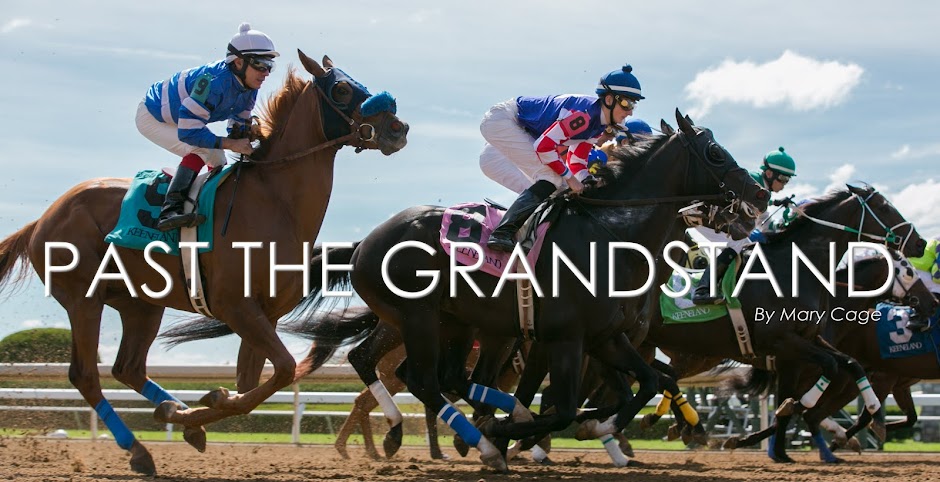There’s no doubt that when
Edward P. Evans sent Pennant Fever to Overbook Farms to visit Storm Cat in 1997
that he was expecting a future star. Pennant Fever came from a long line of
champions and Storm Cat – standing for $150,000 – had sired many talented
horses himself, including the Preakness Stakes (GI)- and Belmont Stakes
(GI)-winning Tabasco Cat. The two together had already produced Stormin Fever,
who would go on to win the Sport Page Handicap (GIII) and place second in two
runnings of the Vosburgh Stakes (GI).
Pennant Fever’s bloodlines
hinted that she would become a sensational broodmare. She was by the great sire
and 1977 Triple Crown winner, Seattle Slew, and out of the black-type-placed
Letty’s Pennant, who also produced the grade three-winning R. Associate. Her
third, fourth, and fifth dams were all Reine De Course mares. Her third dam,
Nalee, was a multiple stakes-winning mare who produced a group one winner, five
graded stakes-placed horses, two ungraded stakes winners, and two
black-type-placed horses. Her fourth dam, Levee, was the multiple
stakes-winning 1970 Broodmare of the Year and dam of four stakes winners,
including the champion Shuvee. Pennant Fever’s fifth dam was Bourtai, a
stakes-placed mare who produced six black-type horses and two Broodmares of the
Year.
Like Pennant Fever, her 1998
foal would descend from female family number nine, which is most famous for
producing the multiple group- or grade-one-winning horses Alydar, Galileo, Sea
the Stars, and Shergar, the first Triple Crown winner in Sir Barton, the only
horse to defeat the great Man O’ War in Upset, and some of the most influential
sires of all-time in Bull Lea, Fair Play, Mahmoud, Nasrullah, and Royal
Charger.
Pennant Fever’s second foal by
Storm Cat was born on April 2, 1998. The nearly black filly grew into a beautifully
built racehorse by the name of Raging Fever. Edward Evans sent her to trainer
Mark Hennig in New York, where the filly reeled off five victories in her first
five starts. Among these wins were trips to the winner’s circle in the
Adirondack Stakes (GII), the Matron Stakes (GI), and the Frizette Stakes (GI).
Though she was sent off as the favorite in the 2000 Breeders’ Cup Juvenile
Fillies (GI), she weakened to finish sixth.
Despite her disappointing run
in the Breeders’ Cup, Raging Fever continued her glory. She began her sophomore
campaign with a second-place finish in the Dame Mysterieuse Stakes at
Gulfstream Park and a third-place finish in the Beaumont Stakes (GII) at
Keeneland. She was entered in the prestigious Kentucky Oaks (GI), but it was
never a very serious entry and she was scratched.
Due to a fracture of the growth
plate in her stifle, Raging Fever did not start again until December. She made
her return in the Garland of Roses Handicap at Aqueduct, sweeping to victory
for the first time since October of the previous year. She wheeled off another
win in her subsequent start, the First Lady Handicap (GIII) at Gulfstream.
Following a defeat in the
Shirley Jones Handicap (GII) at the same track, Raging Fever scored two more
consecutive wins in a pair of graded stakes: the Distaff Breeders’ Cup Handicap
(GII) and the Bed o’ Roses Breeders’ Cup Handicap (GIII). After being beaten by
a longshot in the Shuvee Handicap (GII), Raging Fever crossed the wire
victoriously in the Ogden Phipps Handicap (GI). She had found the winner’s
circle in a grade one race for the first time since her two-year-old campaign.
It was nearly another year
before Raging Fever won again. Yet, she placed in four graded stakes races
between her triumph in the Ogden Phipps and in her repeat victory in the Bed o’
Roses. However, her win in the 2003 Bed o’ Roses was the final time Raging
Fever entered the winner’s enclosure.
Raging Fever left the racetrack
with $1,458,198 in earnings from
eleven wins, seven seconds, and three thirds in twenty-six starts. She found a
home at Evans’ Spring Hill Farm in Virginia and was first sent to the prosperous
sire Gone West. Raging Fever has not yet produced a stakes winner, but if her
pedigree is any indication, it would be no surprise if she did.
In November of 2011, the
complete dispersal of the deceased Edward P. Evans’ estate continued at the
Keeneland November Breeding Stock Sale. Raging Fever, her full sister in Last
Fever, and her 2011 Smart Strike filly were offered at the sale. Last Fever
sold for $65,000 to Elaine Lawlor, Raging Fever’s 2011 filly sold for $1,000,000
to Stonestreet Stables & George Bolton, and Raging Fever – in foal to
Quality Road – sold for $725,000 to R.J. Bennett, agent.
Raging Fever may never have
been presented with an Eclipse Award, but she is still a champion. As I said in
my blog post To See a Champion, “a champion is any horse that has accomplished
great things.” Raging Fever is not just a champion for winning three grade ones
or for being royally bred, but she is a champion for enduring hardships while
still maintaining an impressive race record. Perhaps she will not be the
broodmare she was expected to be, or perhaps she will someday produce a
champion. Nevertheless, Raging Fever was bred to be a star and she accomplished
just that.
 |
| Raging Fever Photo by Terri Cage |
Remember to like Past the Grandstand on Facebook and follow Past the Grandstand on Twitter! Links can be found on the right side of the blog.

No comments:
Post a Comment